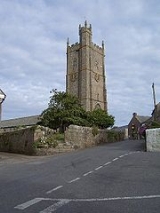
Paul Parish Church
Encyclopedia
Paul Parish Church is a parish church
in the Church of England
located in Paul
, Cornwall
, UK
.
, a Welsh saint. The church building is medieval but was largely destroyed in a raid by the Spanish in 1595.. It was rebuilt by 1600..
for shipping. The tower contains six bells, three date from 1727 by Abraham Rudhall and the remaining three from 1950.
writers Nicholas Boson
, Thomas Boson
and John Boson
are all buried in the churchyard, and a monument in the church by John Boson (to Arthur Hutchens, d. 1709) is the only surviving lapidary inscription in traditional Cornish.Within the village churchyard there is a memorial to Dolly Pentreath
, reputedly and disputedly the last native speaker of Cornish. This memorial was placed there by Louis Lucien Bonaparte
, a relative of Napoleon Bonaparte, and the Vicar of Paul in the 19th century.
Parish church
A parish church , in Christianity, is the church which acts as the religious centre of a parish, the basic administrative unit of episcopal churches....
in the Church of England
Church of England
The Church of England is the officially established Christian church in England and the Mother Church of the worldwide Anglican Communion. The church considers itself within the tradition of Western Christianity and dates its formal establishment principally to the mission to England by St...
located in Paul
Paul, Cornwall
Paul is a civil parish and village in Cornwall, United Kingdom. It is situated two miles south of Penzance and one mile south of Newlyn.The village of Paul is represented on Penzance Town Council...
, Cornwall
Cornwall
Cornwall is a unitary authority and ceremonial county of England, within the United Kingdom. It is bordered to the north and west by the Celtic Sea, to the south by the English Channel, and to the east by the county of Devon, over the River Tamar. Cornwall has a population of , and covers an area of...
, UK
United Kingdom
The United Kingdom of Great Britain and Northern IrelandIn the United Kingdom and Dependencies, other languages have been officially recognised as legitimate autochthonous languages under the European Charter for Regional or Minority Languages...
.
History
The church is said to have been founded in 490 by Paul AurelianPaul Aurelian
Paul Aurelian is a 6th century Welsh saint, who became one of the seven founder saints of Brittany....
, a Welsh saint. The church building is medieval but was largely destroyed in a raid by the Spanish in 1595.. It was rebuilt by 1600..
The tower
The tower is constructed of granite with double buttresses. It is 89 ft tall and is surmounted with a turret 20ft tall. This acts as a daymarkDaymark
A daymark or a day marker is a structure such as a tower constructed on land as an aid to navigation by sailors. While similar in concept to a lighthouse, a daymark does not have a light and so is usually only visible during daylight hours...
for shipping. The tower contains six bells, three date from 1727 by Abraham Rudhall and the remaining three from 1950.
Burials and monuments
The Cornish languageCornish language
Cornish is a Brythonic Celtic language and a recognised minority language of the United Kingdom. Along with Welsh and Breton, it is directly descended from the ancient British language spoken throughout much of Britain before the English language came to dominate...
writers Nicholas Boson
Nicholas Boson
Nicholas Boson was a writer in, and preserver of, the Cornish language. He was born in Newlyn to a landowning and merchant family involved in the pilchard fisheries....
, Thomas Boson
Thomas Boson
Thomas Boson was a writer in the Cornish language and the cousin of Nicholas and John Boson. Thomas helped William Gwavas in his Cornish language research, and wrote an inscription in Cornish for Gwavas's hurling ball. He also made translations of the Ten Commandments, the Apostles' Creed, the...
and John Boson
John Boson (writer)
John Boson was a writer in the Cornish language. The son of Nicholas Boson, he was born in Paul, Cornwall. He taught Cornish to William Gwavas. His works in Cornish include an epitaph for the language scholar John Keigwin, and the "Pilchard Curing Rhyme". He also translated parts of the Bible, the...
are all buried in the churchyard, and a monument in the church by John Boson (to Arthur Hutchens, d. 1709) is the only surviving lapidary inscription in traditional Cornish.Within the village churchyard there is a memorial to Dolly Pentreath
Dolly Pentreath
Dolly Pentreath, or Dorothy Pentreath was probably the last fluent native speaker of the Cornish language, prior to its revival in 1904 and the subsequent small number of children brought up as bilingual native speakers of revived Cornish.She is often stated to have been the last monoglot speaker...
, reputedly and disputedly the last native speaker of Cornish. This memorial was placed there by Louis Lucien Bonaparte
Louis Lucien Bonaparte
Louis Lucien Bonaparte was the third son of Napoleon's second surviving brother, Lucien Bonaparte. He was born at Thorngrove, mansion in Grimley, Worcestershire, England, where his family were temporarily interned after having been captured by the British en route to America A philologist and...
, a relative of Napoleon Bonaparte, and the Vicar of Paul in the 19th century.

